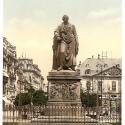Goethe in the Roman Campagna
Documentation:
Rudolf M. Bisanz offers his opinion on the significance of Tischbein’s Goethe in the Roman Campagna :
“The product of a transitional period in art history and of a restless and quickly changing aesthetic climate, the painting was, from the start, entangled in extra-pictorial associations. Literature, the classics, history, archaeology, physiognomy, art theory, and politics, to name just the topmost interdisciplinary connections, furnished its references. Its cultural celebrity status reached its zenith in 1887, its centennial, when at the height of the Goethe cult during the Gründerzeit [age of rapid economic growth], Freifrau von Rothschild donated the work to the Staedelsches Kunstinstitut.”
Rudolf M. Bisanz, “The Birth of a Myth: Tischbein’s Goethe in the Roman Campagna,” Monatshefte, vol. 80, no. 2 (Summer 1988): 187.
In a 9 December 1786 letter to the Swiss writer/physiognomist/theologian Johann Kaspar Lavater (1741-1801), Tischbein gave an eyewitness account of Goethe:
"You were completely right in everything you had to say about Goethe. Certainly, he is one of the truly excellent men that one can ever know. Imagine my indescribable joy during the last week since Goethe arrived unexpectedly here; and now he is staying with me in my rooms. From morning to night, I enjoy making the rounds with this exceptionally wise man. As you recognize Goethe's merits, and as you know of my deep respect for great men, you can now easily think what a diversion this is for me. My dear Lavater, if only I could have the opportunity to show you these ruins upon which so many great deeds transpired. Here for the first time a living being appears truly grand; it is as though he is seen better. Goethe is a hardworking man, just as I in my aimless musings would wish to see him. I have begun his portrait and it is to be life-sized, showing him just as he sits upon those ruins and reflects upon the fate of the works of man. Among all the promises I have made you, and which I have never fulfilled, this one shall be carried out, and I shall certainly send you a drawing of his portrait. I want to draw his face correctly, so to be true to appearances, for one can hardly find a more serene and expressive face. I have found him in person to be much as I had imagined. Yet I could not have imagined the immense tranquility and stability in that lively sensibility, nor that he would be so well informed and feel so very much at home here. What still pleases me the most about him is the simplicity of his life. Because he is content with so very little, he has only asked me for a little corner where he can sleep and work unhindered, and for the most simply prepared meals possible. Now he sits and works every morning finishing his Iphigenia on Tauris. Around nine in the mornings he goes out to look at the great works of art here....He allows himself little contact with the mass of humankind, paying no visits whatsoever, except to artists."
Quoted in John F. Moffitt, "The Poet and the Painter: J.H.W. Tischbein's 'Perfect Portrait' of Goethe in the Campagna (1786-87)," The Art Bulletin, vol. 65, no. 3 (September 1983): 442.
About the Artist
Died: Eutin, Holstein, 1829
Nationality: German


 Buy the Book
Buy the Book